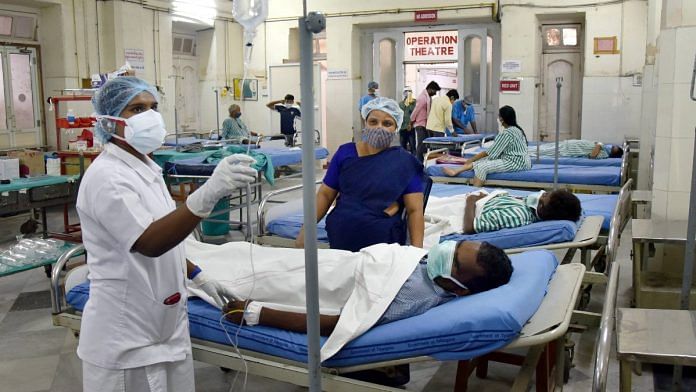New Delhi: The Covid pandemic may still have some time left before it runs its course in India but one epidemic that certainly seems to have been controlled is that of mucormycosis or black fungus.
The jury is still out on why the black fungus was widespread — was it merely steroid overuse, as the Modi government believes, or were there other factors such as unsanitary conditions in hospitals or use of less sterile industrial oxygen? But doctors, in general, agree that while Covid cases are still trickling in, the dreaded black fungus has beat a retreat.
“Mucormycosis cases happened at the peak of the Covid second wave among patients who had high blood sugar and were immunocompromised. Now, Covid cases are down and we are not seeing mucormycosis,” said Dr S. Chatterjee, consultant medicine, Indraprastha Apollo Hospitals.
“The compromised immunity was both because of Covid and because of use of steroids. Post-Covid we saw the same kind of reduction in T-cells as one sees in patients of HIV etc,” he added. “What could have also added to the problem was when oxygen used was not pure or the oxygen had not been dehumidified.”
But several other doctors that ThePrint spoke to highlighted the role played by industrial oxygen at the peak of the Covid oxygen crisis.
“The black fungus spore has to come into the system from somewhere. That aspect is being ignored in this simplistic explanation that steroid overuse caused mucormycosis,” said a senior doctor on the condition of anonymity.
“Also, many of the big hospitals did treat fungal infections; the question is how many patients got the infection there and how many came from outside,” the doctor added.
“At the peak of the second wave, oxygen was used in homes and small establishments with no experience of sanitary precautions.”
He is not the only one to underline the role of industrial oxygen.
In a statement issued during the second wave, the Indian Medical Association too had struck a note of caution.
“While industrial oxygen is being shunted towards the hospitals, it is important to address the differences between the medical oxygen and industrial oxygen. Medical oxygen is a type of oxygen that is produced and used specifically for medical purposes,” the statement said.
“Medical oxygen can only be generated by medical air compressors. The medical oxygen generators or compressors usually are in oil-free or oil-less varieties. The transport and storage cylinders, rather the entire supply chain, strictly control the presence of water to prevent the rusting process inside the cylinders.”
Among the signatories of the statement were IMA national president Dr J.A. Jayalal.
In fact, “sanitisation and handling of oxygen gas cylinders” was the first point in a correspondence by PGIMER Chandigarh researchers published in the The British Medical Journal soon after the epidemic swept through the country.
Also read: Slow-growing second dose virus delays Sputnik V’s entry into India’s govt vaccination drive
Overuse of steroids, says govt
In July, the Modi government told the Rajya Sabha that until the 15th of that month, a total of 45,432 cases of mucormycosis were reported, which led to 4,252 deaths.
The most common presentations of mucormycosis were rhinocerebral (77.6 per cent), cutaneous (4.3 per cent) and pulmonary (3 per cent) — nose and brain, skin and lungs respectively.
A large majority of mucormycosis patients (84.4 per cent) had reported a history of Covid-19, the government said.
ThePrint reached the Ministry of Health over email for the latest mucormycosis numbers. This report will be updated when a response is received.
A senior official in the government, however, told ThePrint that the latest numbers are “not available”.
The government also insists that the black fungus epidemic was caused by steroid overuse.
“Mucormycosis has multiple underlying factors. The first is steroid use, then diabetes mellitus and hospitalisation due to Covid,” Dr V.K. Paul, member (health), NITI Aayog, and head of several committees on Covid, told ThePrint.
“Also, patients would often have been admitted in the hospital two weeks or so before developing this problem. Generally, it is a medium-term complication,” he added. “With increased awareness, steroid use has become more rational and restricted. And doctors are more alert to better control of diabetes and hygienic practices.”
Dr Paul ruled out industrial oxygen as being one of the causes of the epidemic.
“You have to understand the number of active Covid cases is now down from over 35 lakh to 3 lakh. Industrial oxygen is not to be blamed,” he said. “Had it been so, why would hospitals that never used industrial oxygen report such cases. Mucormycosis also occurred among those who required no oxygen therapy. I believe it was largely due to the liberty that we took with steroids.”
Some experts like Dr K.S. Reddy, president of the Public Health Foundation of India and adjunct professor of epidemiology at Harvard, believes it is difficult to pin-point the cause.
“It is difficult to say without clear numbers on what was the incidence of mucormycosis earlier and what it is now. But there are two things that are necessary — one is an immunocompromised person and the other is a source to introduce the fungus into the body,” he said. “That steroid overuse played a role in making patients immunocompromised is generally well-accepted. As for the source, there are multiple theories — it could have been poor sanitary precautions in oxygen administration.
“Many people also blame the use of industrial oxygen that is not as sterile as medical oxygen. Even excessive use of antibiotics could have played a role,” he added. “Whatever it was, many of those things may have been remedied now. We are probably taking greater care both in administration of steroids and also use of oxygen.”
(Edited by Arun Prashanth)
Also read: Fatigue, hair loss, depression — study on long Covid shows what Wuhan patients suffer a year on



